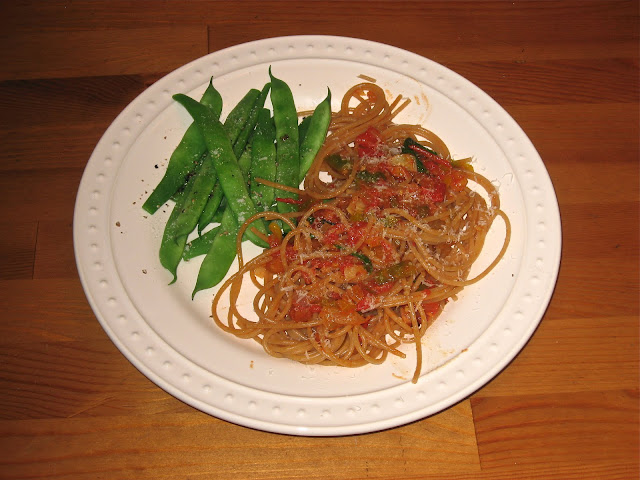I have had quite the bounty of cucumbers this year. Perhaps I was a little overzealous in my planting after last year's early August cucumber death, but at least I've had plenty to work with for experimenting. Refrigerator pickles are quick, easy, and pretty hard to mess up. You can play around with the ingredients and proportions and the worst that will happen is an underwhelming pickle. I've had more success than failure and have enjoyed every bite either way. Here, from left to right, are Spicy Mustard, Cornichons, Dill, Habanero, and Basil pickles.
I grew an heirloom variety of cucumbers called
Parisian Pickling. These are great as they can be picked at any size, most notably when they are quite small to be made into Cornichons, those delicious little cocktail pickles. However, I found that these cucumbers were also sublime when left to grow to full size. They were crisp, light, mildly sweet, with tender skin and seeds. And obviously plentiful. Their only drawback was the burps. I seemed to have two variations of burps, (perhaps some seed contamination?): fewer, larger burps that were easily pushed off with a thumb or cucumbers that were absolutely covered in tiny little spines that needed rubbing off with a cloth, (those in the upper right in the photo). Either way, they were worth the additional effort and I plan on growing them again next year.

On to the recipes! All of these recipes can be made with any shape of pickles. The main variable is how long it will take the flavor to saturate the cucumber: round slices are the fastest, followed by spears, and whole pickles will take significantly longer. Simmering the liquid (and dissolving any salt) will make the cucumbers pickle faster but putting everything in cold will result in slightly crisper, greener pickles. All recipes can be increased or decreased for the desired size of jar. Make sure the liquid covers the cucumbers: if you're a little short, go ahead and add a little water to the jar.
Spicy Mustard Pickles (for 1 pint):
- 3 tbsp whole grain mustard
- 2 tsp kosher or sea salt
- 2 tsp red pepper flakes
- 1/4 tsp fennel seed, crushed
- 1 c. water
- 1/2 c. white vinegar
- 1 tbsp apple cider vinegar
- Add all ingredients to a small sauce pan and simmer just until the salt is dissolved.
- Pack your jar with clean pickled (I used sliced).
- Pour the hot mixture into the jar.
- Replace the lid and allow to come to room temperature.
- Refrigerate for 3-10 days.
Dill Pickles (for 1 quart):
- 1 tbsp apple cider vinegar
- 1 tbsp salt
- 1/2 tsp fennel seeds, crushed
- 1/2 tsp red pepper flakes
- 1 tsp black pepper corns
- 1 tsp dill seed (optional)
- 2 garlic cloves, sliced
- 1 1/2 c. water
- 1 1/2 c. white vinegar
- a whole bunch of fresh dill
- Combine all ingredients except for the fresh dill into a small sauce pan and simmer until the salt is dissolved.
- Pack the bottom of the jar with a large handful of fresh dill.
- Pack the cucumbers (I used spears) into the jar.
- Top the cucumbers with even more(!) fresh dill. You can't have enough dill.
- Pour the hot mixture (or allow it to cool to luke warm) into the jar.
- Cover the jar and allow it to come to room temperature before refrigerating for 3-10 days.
Basil Pickles (for 1 pint):
- about 1 dozen large basil leaves
- 1 clove garlic, sliced
- 1 tbsp kosher or sea salt
- 1/2 tsp freshly ground black pepper
- 1/2 tsp red pepper flakes
- 1 tbsp apple cider vinegar
- water
- Put all ingredients except the water into the bottom of the jar.
- Add cucumbers (sliced highly recommended).
- Fill the rest of the jar with cold water.
- Put the lid on and shake the jar.
- Refrigerated for 5 days. While they will last longer, I found the flavor of these to be at their peak between 5 and 25 days.
Cornichons (for 1 pint):
- 1 tsp fennel seed, crushed
- 1 tsp black peppercorns
- 1/2 tsp red pepper flakes
- 1 clove garlic, sliced
- 2 tsp kosher or sea salt
- 1/2 c. white vinegar
- 1 c. water
- Add all ingredients to a small sauce pan and simmer just until the salt is dissolved.
- Pack your jar with small cucumbers.
- Pour the hot mixture into the jar.
- Replace the lid and allow to come to room temperature.
- Refrigerate for 7 days.
Habanero Pickles (for 1 quart):
- 1 habanero (don't even think about putting in another)
- 1 tbsp salt
- 1 tsp ground black pepper
- 1 clove garlic, sliced
- 2 tbsp apple cider vinegar
- 1 c. white vinegar
- 2 c. water
- Pack your jar with cucumbers, (I recommend sliced as they are quite spicy).
- Combine all ingredients and pour them on top of the cucumbers.
- Replace the lid and refrigerate for 3 days.
All pickles should last in the refrigerator for at least 2 months, though I doubt you'll be able to keep them around that long. Feel free to play with different herbs and spices and adjust the saltiness to your own preference. Pickling cucumbers can be found at most farmers markets and regular cucumbers can also be used.
Enjoy!
P.S. It's my 100th post! Yay!

















